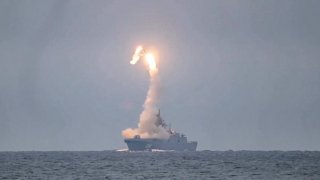Russia's Tsirkon Missile Packs a Destructive Punch
The Russian Navy has reportedly decided to fast-track the remainder of Tsirkon’s state trials.
Here's What You Need to Remember: Tsirkon is a winged, hypersonic anti-ship missile that is reportedly capable of reaching speeds of up to Mach 9 and performing mid-flight maneuvers.
Russia’s hypersonic Tsirkon missile has undergone yet another round of testing, bringing the weapon a step closer to combat readiness.
Russia’s Ministry of Defence announced on Monday that its Navy had performed a test launch of the Tsirkon test launch from the White Sea at a notional surface target on the coast of the Barents Sea. “According to live monitoring data, the Tsirkon missile successfully hit a target directly at a range of over 350 km. During the test, the tactical and technical characteristics were confirmed. The flight speed reached nearly 7 Mach,” the defense ministry said in a statement. Additionally, the Ministry of Defence published a brief video clip from the exercise on its Youtube channel. The footage showed the Admiral Gorshkov-class frigate Admiral Flota Sovetskogo Soyuza Gorshkov, clearly demarcated by its pennant number 454, moving into firing position. The video then showed the Tsirkon missile being launched and flying at an upwards trajectory from several different angles.
Tsirkon, also known as “Zircon,” was launched at least four other times from Admiral Gorshkov since January 2020, hitting both ground and sea targets at distances ranging from 350–500 kilometers. Tsirkon is a winged, hypersonic anti-ship missile that is reportedly capable of reaching speeds of up to Mach 9 and performing mid-flight maneuvers. Tsirkon’s operational range remains unclear, with estimates ranging from 1,000–2,000 kilometers depending on the circumstances of the engagement. A defense insider recently told TASS news that Tsirkon boasts a range of roughly 1,500 kilometers for ground targets and “slightly less” than that for hitting naval targets. Tsirkon appears to have the potential to hold U.S. Navy Carrier Strike Groups at risk and to significantly impede these formations from operating effectively.
The Russian Navy has reportedly decided to fast-track the remainder of Tsirkon’s state trials, with a flurry of testing activity planned over the course of August. “The first launch from the Admiral Gorshkov frigate within the state trials is planned for the first part of August,” a defense industry insider told TASS state news. “The second part of August will see flight trials of Zircon from the Severodvinsk nuclear submarine," the source added.
Live-fire tests from submarines are the next major step on Tsirkon’s path to combat readiness, as the hypersonic missile is expected to figure prominently into the capabilities of Russia’s new Yasen-class of nuclear-powered cruise missile submarines. Reports surfaced earlier this month that the Admiral Gorshkov-class frigate Admiral Golovko will become the first active-service vessel to receive the Tsirkon upgrade. Other possible Tsirkon fittings include the Kirov-class battlecruisers Admiral Nakhimov and Petr Velikiy. Russia’s Ministry of Defence is also eying select corvettes from the Gremyashchiy-class and Karakurt-class. Russian president Vladimir Putin previously appeared to suggest that a land-based Tsirkon variant is in the works, but the status of those development efforts remains uncertain.
Defense industry insiders told Russian state media earlier this year that Tsirkon is expected to enter service in the “first half of 2022,” pending the success of its upcoming submarine trials.
Mark Episkopos is the national security reporter for the National Interest.
This article first appeared earlier and is being reposted due to reader interest.
Image: Wikimedia Commons

